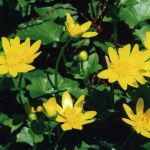| Common Name: |
Lesser Celandine |
| Other Names: |
Pilewort |
| Botanical Name: |
Ranunculus ficaria |
| Genus: |
Ranunculus |
| Family: |
Ranunculaceae |
| Native Location: |
Europe, W Asia, NW Africa. |
| Cultivation: |
Moist, neutral to alkaline soil in sun or shade. Ranunculus ficaria is particularly invasive when grown in shade, which encourages formation of bulbils at leaf bases. |
| Propagation: |
By seed sown when ripe (species only); by division in spring or autumn. |
| Harvest: |
Plants are lifted after flowering, complete with roots, and used fresh for ointments and suppositories, or dried for use in infusions, liquid extracts, and tablets. |
| Height: |
5-15cm (2-6in) |
| Width: |
30cm (12in) |
| Hardiness: |
Z4-9 |
| Variations: |
var. albus
Has bronze-marked leaves and pale cream flowers, fading to white. |
var. aurantiacus
Syn. Cupreus
Has silver-green leaves with a central bronze mark, and copper-colored flowers. |
Brazen Hussy
Has dark brown foliage and yellow flowers with bronze undersides. |
f. flore pleno
Has double flowers. |
|
| Parts Used: |
Whole plant including roots |
| Properties: |
An astringent, slightly bitter herb that is specifically anti-hemorrhoidal. |
| Medicinal Uses: |
Externally for hemorrhoids, and for perineal damage after childbirth. Often combined with Hamamelis virginiana (See, Common Witch Hazel) in creams and ointments, and with Calendula officinalis (See, Pot Marigold), Hamamelis virginiana (See, Common Witch Hazel) or Plantago major (See, Common Plantain) in suppositories. |
| Warning: |
Harmful if eaten. Skin Irritant |
| Bibliography: |
The Encyclopedia of Herbs by Deni Bown Copyright © 1995, 2001 Dorling Kindersley Limited pg. 340. |
